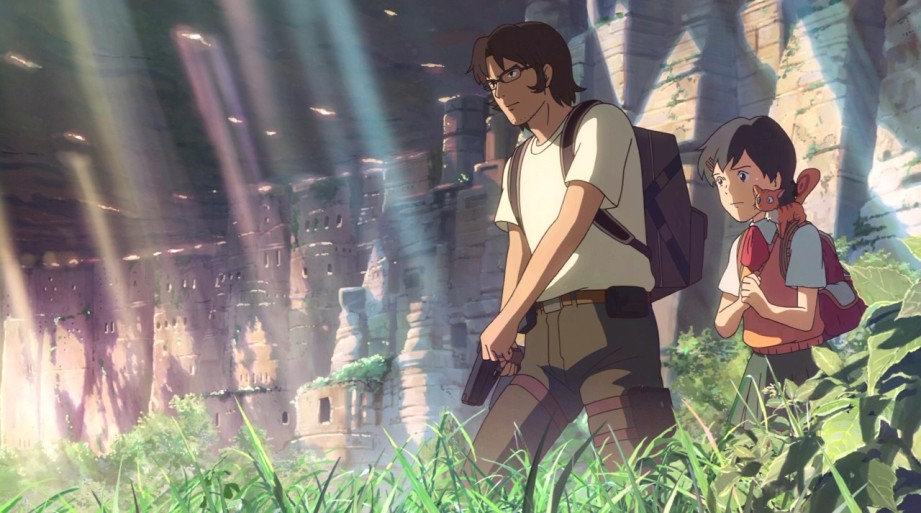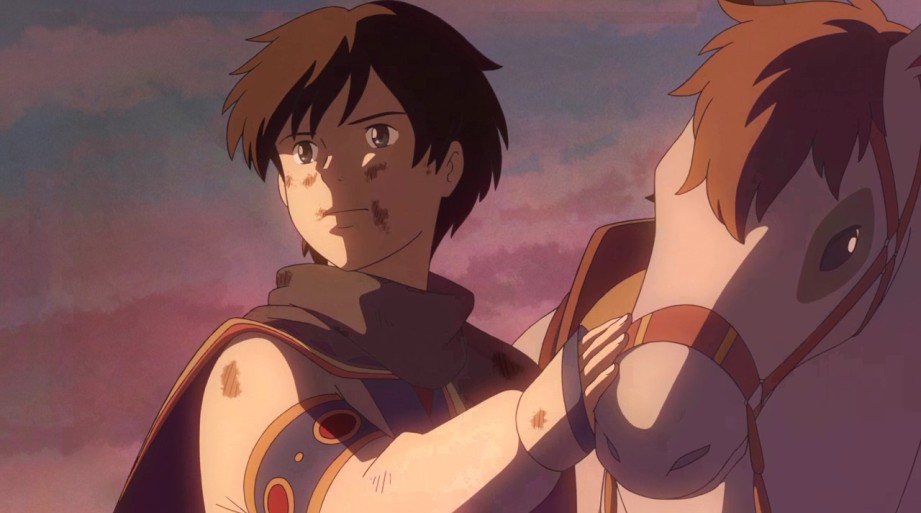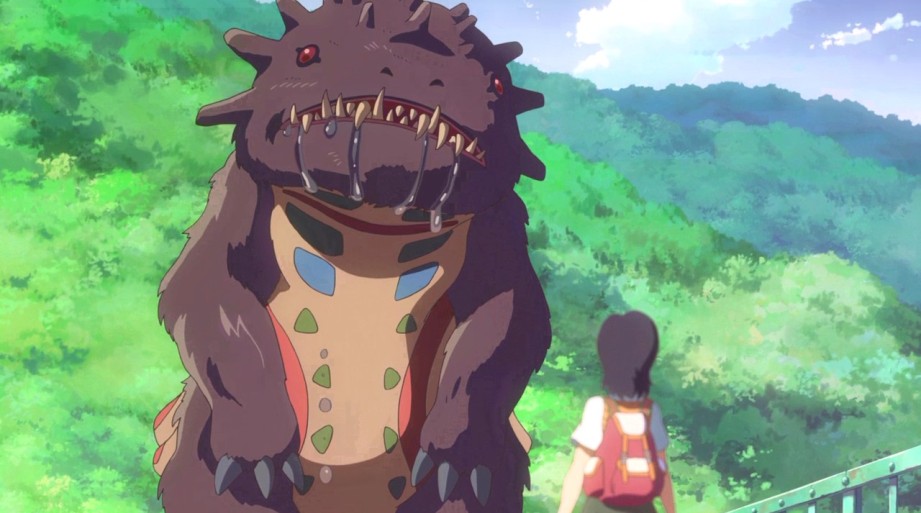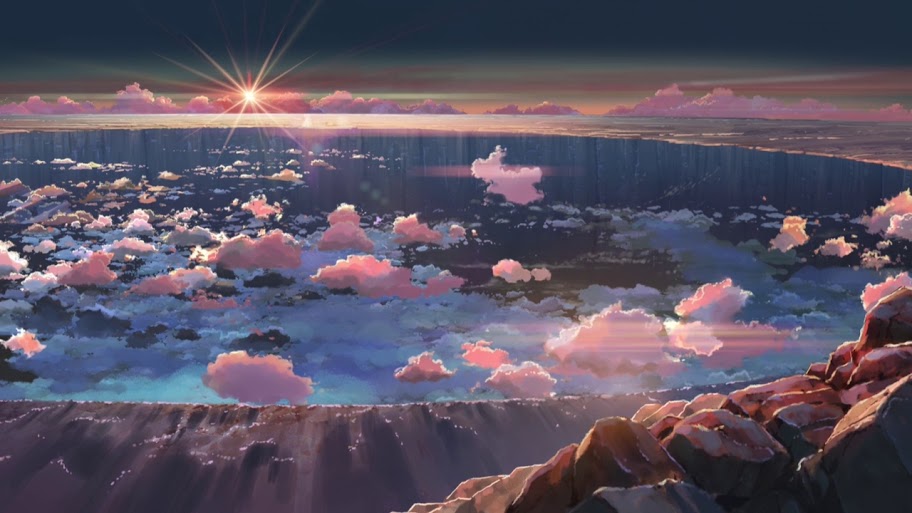Nice review! 9/10 You really enjoyed it XD
I probably would've given it a 7/8 but thats just me. I give your review a 10/10 though ;)

 After school activities have never been this exciting.
After school activities have never been this exciting.
 Welcome back, Ashitaka!
Welcome back, Ashitaka!
 Snorlax has grown some fur over the years.
Snorlax has grown some fur over the years.
 Dammit, where's my camera?
Dammit, where's my camera?
Hoshi o Ou Kodomo tv Review
Story & Characters
In 2002 Shinkai Makoto made waves in the anime world by almost single-handedly making the widely-respected and much-beloved OVA Voices of a Distant Star. Ever since its release, fans have waited eagerly to see what Shinkai might come up with given a proper budget and full staff. Place Promised in Our Earlier Days and Five Centimeters Per Second in particular can be looked at as more refined spiritual successors of Voices. He has been hailed by some as "the next Miyazaki," but such praise is premature at best and hyperbole at worst. While this newest project,too, is a story about longing, about the isolating feeling of loneliness and the desire to make and maintain connections, it establishes the essential storytelling, adventure of Miyazaki Hayao, yet it confirms the remarkable talent Shinkai displayed in his previous efforts. It is long, long overdue, but thankfully he has done an excellent job with the production.
The story opens with the cheerful Asuna, a young girl who lives with her mother, attending a normal life while spending her solitary days listening to a mysterious music emanating from the crystal radio she received from her late father. One day, when on her way to the wood, she runs into a strange creature and is saved by a boy named Shun, who is from the country of Agartha. Though he gives Asuna a blessing in a form of kiss in the forehead, and promises to meet with her later, the next day, his body is discovered. At school, Asuna is lectured by teacher Morisaki that Agartha is a legendary city said to reside in the Earth's core. Her life is about to change, however, when it becomes embroiled in a conflict between the organization Arch Angels and a boy named Shin, who is Shun's younger brother and came to retrieve a key to Agartha taking in the form of a stone. Revealing himself as an ex-member of Arch Angels and his wish to bring back his wife from the dead, Morisaki enters Agartha and Asuna, naturally weighs the intense pros and cons of meeting Shun again, joins the journey to the center of the Earth. It will take all their talents and will to survive the hostility of the its residents and to a new understanding of the world around them.
Hoshi o Ou Kodomo bears the irrefutable stamp of Shinkai Makoto's direction, storytelling, and artistry. It is quite interesting to see how many elements of his early works became staples in this later effort. Shinkai's previous projects have shown that his storytelling style is heavy "distance" and "separation," this time Hoshi revolves around the themes of "life" and "death", separation between the living and the death in a way that has rarely been touched in this medium before. While it may say so on the surface the plot of this film is not a journey to a magical land beneath the earth's surface but it is a journey to accept the separation between life and death and move on from loss.
As with Hoshi, Shinkai was directly involved in nearly every aspect of this production, which leaves his stamp on this work as indelibly as Miyazaki does on any of his movies. Following the wondrous settings of Place, the wonderful world of Agartha serves quite well here: you have the wonderfully exotic locales, fascinating and inventive creatures, strong environmentalist elements. All the landscapes and scenery are wondrous to look at and vivid in their detail; the imagination it took to put together something like this, which doesn't exist in the real world, and yet still make it look convincing is incredible. The mythical set is also interesting, with the ungainly-looking and ugly Quetzalcoatl creatures contrasting markedly with the sleek and graceful flying ark, or the world's end abyss. This is a world where windmills and guns are readily used, but the technology beyond that seems fairly primitive.
Every great movie requires an appealing protagonist, and this one has Shinkai's best heroine to date. Asuna is lively, adventuresome, and charismatic; though somewhere between cute and pretty, that is the least of the factors which attracts a viewer's attention to her. She is a gentle, peace-loving soul; though full of youthful exuberance, she possesses a wisdom and maturity well beyond her years. While sometime she may look like a damsel-in-distress, that doesn't stop her from being lovable. Shin has been living in the shadow of his older brother, naturally he bears a complex. Asuna sees Shun in him, but Shin has been taught to hate humans, and stays away. Of course, that doesn't last long, with Shin wrestling with the notion that they aren't so different. Aside from them, the major adult character is Morisaki, who is like a second father to Asuna; while he may determine to pursue his wish, he is caring man who looks out for Asuna when she doesn't look out for herself, his charming moments would be when he apologizes her for dragging her into this mess.
Though the focus of the movie remains firmly on the three protagonists for most of its run, a bevy of interesting supporting cast members also make their presences known. Chief amongst them is a fox cat which Asuna acquires early on and who becomes a constant companion. Though he doesn't talk, he is so believably expressive and natural-seeming in his actions that he is more like another character than a simple animal companion. A few residents of Agartha also add to raise the hostility towards the surface, including its humans, which were divided into many tribes, the massive, brown-skinned Quetzalcoatl are the most interesting denizens, as they are seen in ancient animal forms and they seem to have some degree of supernatural ability, amongst other things.
The central characters all have something that they need to resolve for themselves, that being the loss of someone
important. This search for resolution is the driving force behind this movie and is the true story at play here. They
are all chasing after hope for those who they have lost, but they have to dig deep to find the strength to accept things
and move on. In anyone else's hands this premise and message could easily have been over done or simply mishandled
but Shinkai directs it with such nuance and subtlety that everything just comes together in glorious fashion.
Rating:
Art
Character designs are typical of Shinkai's work: simple features and hairstyles, with eyes smaller than the norm by anime standards. His character designs have improved markedly since his work on Voices. Faces of adult male like Morisaki are taken with care. This is furthered by distinctive patterns of dress amongst the various different Agartha grous. And though female figures like Asuna are depicted with a distinct figure, not much emphasis is given to it nor is there any effort put into making her look cute. So anyone looking for fanservice in one of his films is barking up the wrong tree. But if it's scenery porn you're looking for, then ready your camera.
The background is incredible. Aside from the aforementioned Agartha, the town where Asuna lives is as gorgeous as can be
expected, all the detail and beauty is in the backgrounds and in subtle movements, nearly photorealistic recreations of
actual real-world settings, rather than in passive theatrics a'la the rocket sequence in Place. There're brief moments where the animation breaks out of the action style, when a
Quetzalcoatl sends Shun flying, impaled by the the iron bar behind and blood splashed are enough to satisfy action fans.
This is cutting-edge artistic work which produces a plethora of beautifully detailed scenes. Most impressive are the
breathtakingly gorgeous sunsets, an artistic theme which Shinkai uses repeatedly throughout the movie, and with good
reason. Quite simple that we have seen all of Shinkai's works, we know there is still so much more that not even he
himself has explored, and the universe he has created here is something majestic to behold.
Rating:
Sound
The score while is a bit more adventurous are still composed with string quartet numbers and piano-based themes heavily reminiscent of previous works, which shouldn't be surprising since Tenmon, the individual responsible for scoring those, also worked with Shinkai on this project. These themes are very effective at supporting and reinforcing the moods of the scenes. The melancholy violin melody used on two different occasions is also a nice touch, and the ending theme song "Hello Goodbye & Hello", whose lyrics were performed by Kumaki Anri, is beautiful.
The cast is composed primarily of veterans, all of whom clearly get into their performances and thus do a fine job
overall. Key seiyuu include Kanemoto Hisako, who gives Asuna a remarkable and naturally heartfelt performance, Irino
Miyu, who both voice Shun and Shin, gives the two brothers a distinctive tones, one gentle one hot-tempered, this is
perhaps his best return after Haku in Spirited Away. The adult performance is turned in by Inoue Kazuhiko, who perfectly
captures the image of Morisaki.
Rating:
Presentation
Hoshi o Ou Kodomo does not quite have the emotional appeal that Five Centimeters Per Second did, and though its writing
is great, it may be criticized for looking like a Ghibli movie, but it is still a visually impressive and highly
sentimental tale which speaks to the chase that most people hope for meeting those who they have lost. Though it may not
differ much in style, tone, sound, or look from his other productions, you will not find another anime director better
at hitting just the right note, and using just the right combination of lines and visuals, to much such stories work. It
isn't the best anime movie, but it's safe to say that it's the first best anime movie in the 2010s. It
reaffirms Shinkai Makoto's status as one of Japan's most gifted and promising young animators and rates as a
worthy view for any anime fan who can appreciate gentle dramatic stories.
____________________________________________________________________________________________
Story: 8
Characters: 8
Art: 9
Animation: 10
Voice: 10
Music: 10
Overall: 9.5
Good:
+Superb production design and animation, excellent sound and music scoring, more adventurous storytelling and friendlier
fare.
Bad:
+Love of old Ghibli cliches and some plot holes.
Rating:
Final Verdict
9.3333 (very good)
Reviewed by Weskalia, Oct 23, 2012
Comments
-
Drakill Oct 23, 2012
-
CyanideBlizzard Retired Moderator Oct 24, 2012
To be honest, I've never actually watched any pieces by Makoto Shinkai before. While praises for his work have been sung numerous times, I never really found myself terribly interested, despite the fact that I love the concept and the beautiful artwork. Nonetheless, I've found as the years progressed I've wanted to track down his work and really give it a sit down, and it's especially so with this piece. My gosh that artwork.
However, despite it all I've found myself strangely attracted to this piece, I can't help but to feel that there's a lot of staples of Ghibli in this movie itself despite the obvious appearance similarity. At least from what I've read and scene, and to be honest I don't mind at all. Matter of fact, amidst all the advertisement I have seen for this piece I am most interested in seeing this first before anything else. I really like the world created and the concept, although it's a shame that it doesn't measure up to some of his character creation in his previous work.
I greatly enjoyed reading this review. I never imagined tackling a review simply because it's a lot of material to cover and I've always figured structure would be different, but you've got sort of a grace to how you do it. I'm really glad as well that you brought in comparisons to the previous works, as that would definitely be a question that fans would be thinking about, as well as the Ghibli comparisons. You made some great points in a well laid out review. This was a fantastic read!
page 1 of 1 2 total items
Only members can post replies, please register.